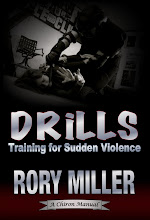November is the National Novel Writing Month or Nanowrimo. The challenge is to finish 50,000 words in one month-- a month with a major holiday, family obligations and all of your regular work, too. Lots of my friends take the challenge and I try to finish something. It's not a novel, but I add 50,000 words to a project.
For the last 28 days, every spare minute has been spent on the IDC manual. IDC was our cop jargon for "Instructor Development Course." So a book on how to teach. Finished it today. Or, at least, thought I did. Then realized I needed to add a new section. No idea why these things always seem to pop into my head in the shower.
So, if anyone is still reading the blog, here's a taste. The Table of Contents:
Introduction
Section 1: The Unique Problem of Self-Defense
Section 1.1: Rarity
Section 1.2 An Open, Not a Closed System
Section 1.3 Surprise, Fear and Speed
Section 1.4 The Problem is Longitudinal
Section 1.5 The Problem Exists in the Real World
Section 1.6 You are Teaching Students, not Subject Matter
Section 2: Subject Matter Expertise
Section 2.1 Knowledge of the Problem
Section 2.1.1 The Ethical and Legal Implications of Using Force
Section 2.1.2 Violence Dynamics
Section 2.1.3 Avoidance; Escape and Evasion and De-Escalation
Section 2.1.4 Counter Assault
Section 2.1.5 Freezing
Section 2.1.6 The Fight
Section 2.1.7 Aftermath
Section 2.2 Applicable Solutions
Section 2.3 Experience Thresholds
Section 2.3.1 Sharing Experiences
Section 3 The Ability to Teach
Section 3.1 Adult Learning
Section 3.2 Assessment
Section 3.2.1 Reading Students
Section 3.2.1.1 Creating Student Profiles
Section 3.2.1.2 Troubleshooting Difficult Students
Section 3.2.2 Reading a Class
Section 3.2.3 Assessing Sources of Information
Section 3.2.4 Assessing Drills
Section 3.2.5 Assessing Techniques
Section 3.3 The Transfer of Information
Section 3.4 Curriculum Development
Section 3.4.1 Curricula in General
Section 3.4.2 Curriculum Design for Long-Term Classes
Section 3.4.3 Curriculum Design for Short Classes
Section 3.4.4 Teaching Groups vs. Singles
Section 4: Principles-Based Teaching
Section 4.1 Background Concepts of Principles-Based Teaching
Section 4.1.1 Building Blocks
Section 4.1.2 Principles
Section 4.1.3 Concepts
Section 4.2 The Process of Principles-Based Teaching
Section 4.3 The Flaws of Principles-Based Teaching
Section 5: Teaching Professional (LEOs, Military and Specialty Teams)
Section 5.1 The Fundamental Fundamentals
Section 5.2 Before You teach, Know the Policies
Section 5.3 Teaching Professionals
Section 5.3.1 Class Structure
Section 5.3.2 Preparation
Section 5.3.3 Class Format
Section 5.3.4 Deciding What to Teach
Section 5.3.5 Setting up the Class
Section 5.3.6 Presentation
Section 5.3.7 Troubleshooting
Section 5.4 After the Class
Section 6: Instructor Ethics
Section 6.1 Ethics
Section 6.2 Student Empowerment
Section 6.3 Assumptions and Biases
Section 7 Business and Marketing, to be contributed by Randy King
Section 8 Tips and Tricks
Appendices
Appendix 1 Building Blocks
Appendix 2 Principles
Appendix 3 Concepts
Appendix 4 Dracula’s Cape as an Example of Operant Conditioning
Appendix 5 Example Flexible Curriculum Template
Appendix 6 Example Revolving Curriculum
Appendix 7 Example Professional Lesson Format
Appendix 8: Sample Safety Briefing




